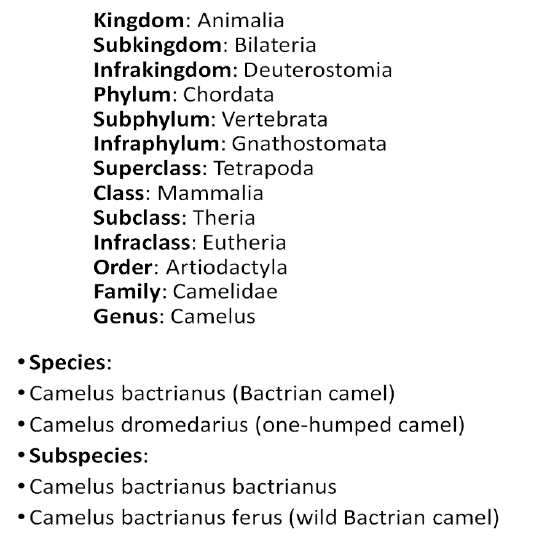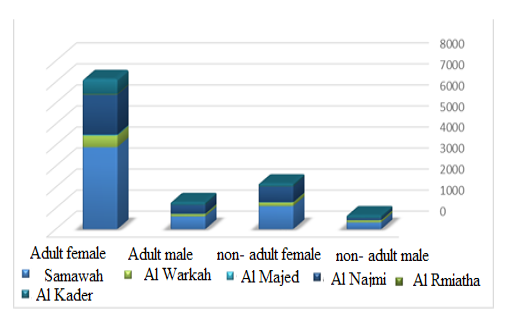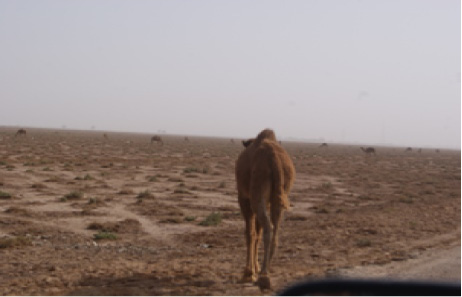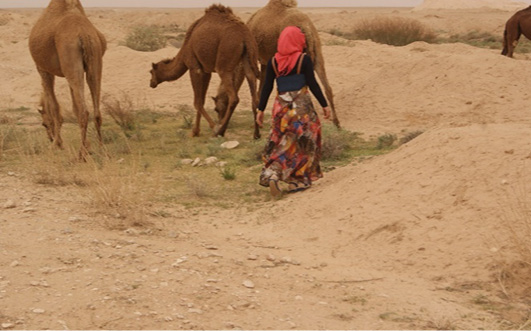Advances in Animal and Veterinary Sciences
Research Article
Studying and Evaluation The Reality of Camelids Breeding in Al Muthanna Province
Waela Kamal Sabri
Al Muthanna University, The Center of Albadia and Sawa Lake Studies, Iraq.
Abstract | The camel is one of the animals that specifically live in a dry environment such as AL Muthanna Governorate, where a desert is occupied about 90.7% of the total area and it is called Badiat al-Salman. Review of literature revealed absence of a specific project that deal with the development of the camelids in Iraq generally and in Al Muthanna province specifically. Therefore, this study is designed to highlight the reality of camel breeding in the province and to describe the varieties of camels, their types in Iraq, the features of the study areas. Moreover, to show the most important diseases that affecting the camels and facing their breeding. The study was based on the field visit and analytical and statistical methods. The results of this study showed that Al Muthanna province inhabitant are one of the first who domesticated the camels in Iraq. The statistics of the Ministry of Agriculture/ Department of Planning 2008 revealed that the total numbers of camels in Iraq and in Al Muthanna province were (58293) and (7205) heads respectively. Out of the total camels in Iraq, Al Muthanna province occupied the third location in camels breeding with a percentage of camel population reached 12.4% after Nineveh and Dhi Qar provinces. The latest statistics 2016-2017 revealed an increase in the numbers of camels in Al Muthanna (17500) head. The breeding of camels approved to deal with a great economic interest and wealthy. The author recommends to promote the breeding of camels in all Iraqi provinces as well as in Muthanna province in particular as this animal consider as the animal of the future.
Keywords | Al Muthanna province, Camel, Economic, Future, Reality
Editor | Kuldeep Dhama, Indian Veterinary Research Institute, Uttar Pradesh, India.
Received | March 06, 2018; Accepted | May 28, 2018; Published | July 25, 2018
*Correspondence | Waela Kamal Sabri, Al Muthanna University / The Center of Albadia and Sawa Lake Studies, Iraq
Citation | Sabri WK (2018). Studying and evaluation the reality of camelids breeding in al muthanna province. Adv. Anim. Vet. Sci. 6(8): 332-336.
DOI | http://dx.doi.org/10.17582/journal.aavs/2018/6.8.332.336
ISSN (Online) | 2307-8316; ISSN (Print) | 2309-3331
Copyright © 2018 Waela Kamal Sabri. This is an open access article distributed under the Creative Commons Attribution License, which permits unrestricted use, distribution, and reproduction in any medium, provided the original work is properly cited.
Introduction
Camels are considered as the oldest domestic animals that man used in travels and carrying goods. One of the oldest discoveries indicates that the camel was domesticated in Iraq about the fourth millennium BC. The archaeologists found a statuette of camel carrying a passenger on the back in the remnants of Halfa Hill in Iraq that belong to the period between 3,000 and 2900 BC. These finding were also supported by the inscription of ancient city of Jil in Lebanon proving that the camel was domesticated in that period (Al Hiti, 1990). In Iraq, the percentages of camelids are (51%), (47%) and (2%) distributed in Al Jazira, Northern and southern Badia respectively. The camels are raised by different Iraqi tribes living and moving in between different Badia, moreover they are crossing the desert to reach another countries like Shamar, Dulaim tribes in the Al Jazira and Northern Badia that cross and reach east Syria. Meanwhile, Anza tribe is living in most western part of the northern badia (Al Nekiab and Al Rutba) until reach Deir al-Zour, while in the territory of Saudi Arabiathey are located in Al Shabaka area. They are called themselves Al Dhamsha, a branch of Anza and the tribe of Dafir that live in the southern Badia in the areas of Al Haya, Johaim, Ayn Assaf and Abtia. Moreover, branches of Shamar are also located in the north of the southern Badia (Burger, 2016). Besides of Bedouin tribes, there are semi-nomadic tribes that seasonally go to grazingin the different areas of the countryside and return back in summer to its homeland in Mesopotamia in Karbala, Qadisiyah, Muthanna and Basra provinces. Among them are semi-stable tribes that called Al-Fatamah and they migrate with their animals during the autumn, winter and spring seasons to the opposite places to the west and south. Each tribe is distinguished its camels by its own decorations and branches. Each tribe travels within its agreed boundaries according to customs and traditions, but these borders sometimes overlap, especially in the seasons of drought.
Classification of Camelids
The camel belongs to the whole family Camelidae according to its feet features and belongs to the animal kingdom. (Fowler, 1998) (Figure 1). The family Camelidae are comprised the following general:
The genus Camelus that includes two species, the C. Dromedarius (one humped camel) and the C. Bactrianus (two humped camel).
The genus Lama comprises Lama glama (the llama), Lama pacos (the alpaca) and Lama guanicoe (guanaco).
The Vicugna vicugna (vicuña), Vicugna vicugna mensalis (Peruvian) and Vicugna vicugna vicugna (Argentinean).
In Iraq, Camelus dromedaries is the dominant one that domesticated because it is suitable for this geographical area and resists its severe desert weather, moreover it is also distributed in other surrounding countries (Al-Salihi, 2016; Mudhar et al., 2016).
Camel Breeds in Iraq and Al Muthanna Province
Several varieties of camels are branched from camel species that divided into different breeds according to the environment and nature. There are two breeds raised in Iraq, these are including:
Al Khawar camels: These camels are distributed in Northern and Al Jizera Badia between Iraq and Syria. They are characterized by the large to medium body size with small head, long legs, short and thin tail, bright colors and highly milk production.
Al Jody camels: These camels are distributed in the southern badia between Iraq and Saudia Arabia (it is extended in Al Muthanna and Basra Badia in Iraq and Najad Badia in Saudia Arabia). They are characterized by large body bones and body and use for transportation and loading stuffs (Al Jubouri, 2017).
According to FAO Census in 1978, the number of Iraqi camels is 330 thousand head, but these decreased to 93 thousand head due to several factors in referred to the report of the Iraqi planning department in 1979. Meanwhile, the estimated private possess of camels is about 70 head for each family within the tribe (Al-Salihi, 2016).
There are various names of camel used in Iraq according to its color and use. According to color, the names of camels are Magater (bright color), Magahem( dark color), Alwedha (the yellow color), Maleha (Sahba), Alhajela (brown color) and Shealah (for integrated white and black color). Meanwhile, the pure white color camels are owned by Dafar and Aneza tribe. Besides, different names also apply for camels according to its use the camels like Thelol (camel use for transportation), Zemal (camel use for loading stuffs and Al fater (camel prepared for slaughtering) (Mudhar et al., 2016).
There are also a camel prepared to be ride of men especially, which it speed up to 16 kilometers per hour and can achieve 120-200km/ day. These camels have a thick eyelashes that protect eyes and a narrow-edged nose to prevent entering of sand. Moreover, camel blood cells are elliptical in shape in compare to human and other animal’s blood cells that help in making more room for oxygen transporting hemoglobin. The average weight of male camel is about 665 kilograms and the female up to 540 kilograms and in rare cases the camel weighs reach about 750 -800 kg (Abdul Samad, 2004). The camels able to work at 5 years, the age of maturity and very strong and carrying a heavy work and continuous until 20 years of age. The reproduction of camels is started at 4-5 years and the female can be fertilized at age 3 or 4 years of age. The pregnancy period is 12 months and in some cases 13 months. The camel has the ability to store the fat in their body. The milk of the camel is wealthy with albumin and lactose and contain Vitamins A, B1, B2, C, E. In one study on camel milk, researcher mentioned that the physical properties of camel milk, especially Ph did not change during the study period that extended for almost 10 months because it contains antibodies that prevent the growing of microorganisms. Moreover, they were also observed slowly increasing in its acidity that remain intact for 12 days. It was more effective to prevent microbial growth and its efficiency was associated with the presence of the lysozyme (Burger, 2016). Camel milk also contains many proteins and immune casein, lacto Ferin, antibodies and other proteins.
Diseases Affecting the Camel in Al Muthanna Province
There are many disease that reported in camelids in Al Muthanna province including:
Parasites , which infect the stomach and intestines, blood parasites (Surra)
Skin diseases including scabies, contagious echtyma, herpes and Ringworm.
Diseases of a variety causes such as diarrhea, which generally affects young camels and respiratory diseases (Respiratory syndrome).
Zoonotic diseases that transmitted from camels to humans as Brucella, Rift Valley fever, rabies and tuberculosis, camelpox and Middle East syndrome (Mers-CoV) the more serious viral disease.
According to statistical data reported by ministry of agriculture, the numbers of infected camels during 12 months in 2008 were 53, 3, 81 and 967 of FMD, Brucella, enteric poisoning and other diseases respectively. Moreover, the percentage of living births was 99%, while the number of died camels during the year were 11, 66 and 123 for males, females and young males and females. The total number of aborted camels was 297 and the total number of infected camel with different diseases was about 1104 cases during that year alone (Ministry of Agriculture statistic, 2010).
The Reality of Camel Breeding in Muthanna Province and its Distribution
The camel breeding in Al Muthanna province, has revealed an increasing in numbers because of the natural increase of the fertility. However, in some years it has fluctuated and decreased for various reasons, but in general it did not affect its natural increasing rate. In 2001, the total number of camels in Al Muthanna province was (3424) head in a percentage of (14.6%) from the total number of camels in Iraq, even though this number decreased from the previous number in 1971, which was (7868) head. This may be due to environmental and health conditions. In 2008, the numbers of non-adult male and female were 332 and 1000 head respectively, while the numbers of adult male and female were 252 and 5621 respectively. Moreover, the total number of all camels was 7205 in a percentage of 12.4% from the total numbers of camels in Iraq according to the National Livestock Survey (Data of the Directorate of Al Muthanna Agriculture, 2018).
In 2010, the total numbers of camels were increased to (11262) thousand heads. The number of non-adult males andfemales were (657) and (2171) heads respectively. While the numbers of adult females and male were (7146) and (1288)respectively (Table 1 and Figure 2).
In 2011, and according to the statistics of providing food for the animal in Al Muthanna veterinary hospital, the number of camels covered by feed processing for the year 2011 were (12500) head. The report was also indicated that the numbersof camels have increased in 2016 - 2017 to (17500) head.The camels are distributed according to the availability of natural plants that feed on them. They are found in Al Mamlaha, Ghadari and in the Sawa Lake surrounding areas (Figure 3) accompanied with the availability ofcamelids preferred small species of a shrub called Salsola imbricate, that also grow in Al Nagmi and different areas of Basiya, which is located in the Al Salman district. Moreover, the number of camelids are increased in Al Salman because of the availability of Haloxylonshrubs that belonging to the plant family Amaranthaceae, the preferred feed of camelids. Camels are also distributed in the desert valleys because of the presence of large number of natural plants, as Artemisia and Astragalusspinosus especially in Wadi Kharaza and Al Ashaly and Al Arad valleys in Al Muthanna province. The camel is considered as multi-variance grazing animals that is feeding on different types of plants more than the other animals. The more preferredplants for camels in Al Muthanna province are including AtriplexIaucelada, Achillea, Anabasis setifereaalopecuroides, Anthophora , Artemiziaherba alba, Anvillergraeini, Astragalus, Avenabarbata, Anthemis L, Arnabiadewnbens and Calligonomcommosum (Figure 4 and 5) (Data of the Directorate of Muthanna Agriculture, 2018).
Table 1: Shows the numbers of different categories of camels in Al Muthanna province
| No. | District | Non-adult male | Non-adult female | Adult male | Adult female | Total |
| 1 | Samawah | 322 | 1100 | 610 | 3900 | 5932 |
| 2 | Al Warkah | 101 | 170 | 110 | 550 | 931 |
| 3 | Al Majed | 7 | 11 | 12 | 45 | 75 |
| 4 | Al Nagmi | 106 | 759 | 420 | 1900 | 3186 |
| 5 | Al Rumiatha | 3 | 10 | 6 | 31 | 50 |
| 6 | Al Kader | 118 | 130 | 130 | 720 | 1088 |
| Total | 657 | 2171 | 1288 | 7146 |
11262 |
Problems and Obstacles Facing Camels Breeding in Iraq
Despite, the fact that camels do not compete other animals on pasture because they are highly resistant to diseases and drought conditions. However, In last decades, the global warming, climate changes, drought and scarcity of rainfall in Iraq in general and in Al Muthanna province in specific, reflect on the growth of natural desert plants. These factors affect on the feeding and grazing of the camelids moreover, the poor eduction of the camels owner to provide the alternative fodder for their animals led to reduce the milk and and meat production especial in the last two years. Moreover, the absence of governorate support for the camels owner led to affect negatively on the breeding of the camel because of the fluctuating of food availability in Al Muthanna province. Meanwhile, in some years, the local province government are provided breeders with 20 -25 kilos per head / year depending on the availability of the appropriate quantity.
In 2008, the problem of animal food shortage in Al Muthanna province reached about 60%, according to the report of the National Survey of livestock in Iraq, which led some camelids owners with their families to migrate
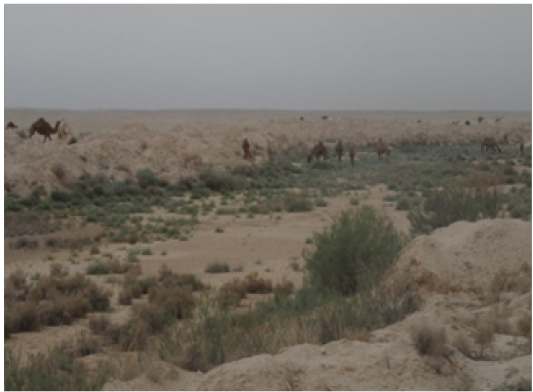
Figure 4: Shows the herd of camels in Wadi Kharaza
and moved long distances randomly to other Iraqi provinces, Where there were grasses and fodder shrubs. Lack of natural plants and shrubs is one of the most important problem, which represents the main obstacle facing camel farming, however, this does not mean that there are no other problems, but they are lighter, such as decrease of water avialibilty, price instability and lack of veterinary services and treatment of animals. All these problem waiting for appropriate solutions to improve the situation of these areas that majorities (54%) of their inhabitants are villagers. Nonetheless, the camel farming sector are also facing a lack of interest due the lack of projects from government to develop this national wealth. According to the reports issued by the Directorate of Al Muthanna Agriculture (2018), there are no projects that concern the development of camelids, besides the support only limited to other projects such as fish, calves & cattle fields, sheep & goats and poultry breeding. In spite of the fact that Al Muthanna province are among the most suitable places to raise camels because of its dry desert environment, the preferred of the camelids. It is worth to say that the camels are the most domesticated animals that need minmium requirement in compare to other livestock with high production of both milk and useful healthy meat that contains a lot of vitamins and minerals. The other problems facing also camels breeding is the lack of veterinary services and treatment of diseases compare to other animals in the province especially because the camels are living in the deserts. The owners are always far from the veterinary hospital in the province and neither able to bring diseased camels to the veterianary hospital niether theveterinarian can go to them.
Conclusions and Recommendations
In conclusion, this study approved that Al Muthanna province is the suitable area both in area and nature in raising camelids, and it is ranked as the third in the number of camels after Nineveh and Dhi Qar provinces. Severe and drought Iraq weather due to global warming led to lack in natural desert plants. Consequently, there is searching and immigrating of camels owner to another Iraqi provinces and decreasing of its number. Moreover, there are obvious lack of attention and absence of governmental projects to develop camels in the province in compare to other livestock considering that camels are highly reproductive, economically and the animal of the future. Therefore, the author recommends to focus on the camelids and its breeding in Al Muthanna province considering its suitability of this province for this animal. Moreover, the local and central government and ministry of agriculture have to give more attention and care for this animal because of its ability to survive and its high productivity even with severe and drought weather. More future studies recommend to do on camelids to solve the problems facing breeding this animal in Al Muthanna province. In addition, camelids diseases need to be control and treat by providing a mobile clinic and vaccination program.
Conflict of Interest
There no conflict of interest for publish this article.
References





